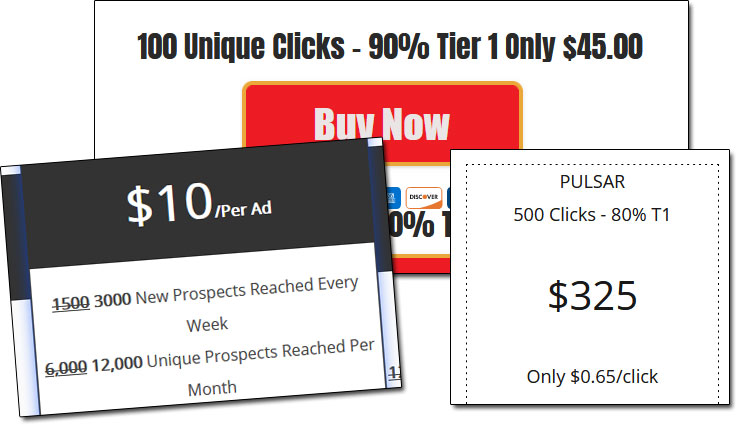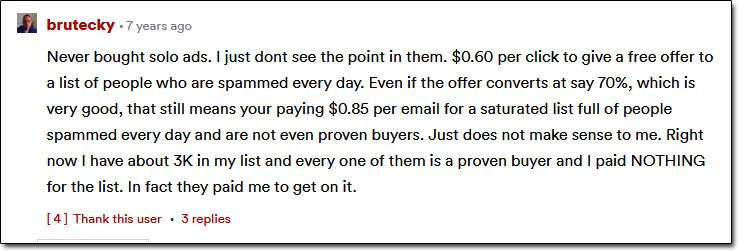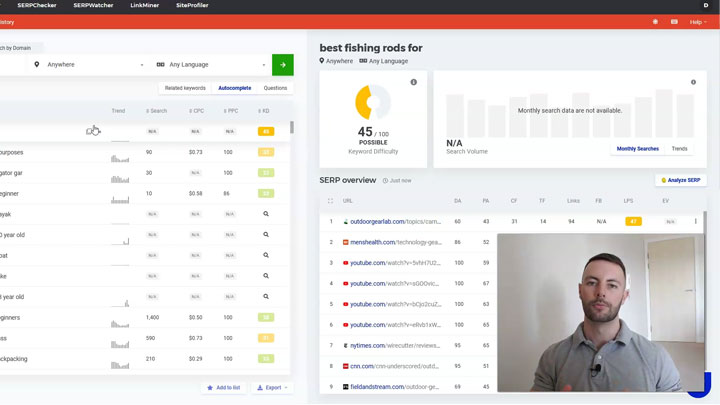Solo ads are often sold as being a simple way to generate fast & large amounts of targeted traffic online & you’re typically led to believe by the solo ad sellers that they’ll provide an almost guaranteed return on your investment.

And will you really find yourself actually making money from the offers that you’re promoting if you dive-in & purchase a solo ad? Or will you just find yourself burning through your cash instead?
Well, over the years I’ve tried a lot of different traffic methods & solo ads have certainly been one of them… Now, in this blog post, I’m going to explain why you should NEVER make the same mistake (and what you should do instead).
So if you’re thinking about throwing some cash on solo ads, be sure to read this first.
What Are Solo Ads? | How Do Solo Ads Work? | Tiered Traffic Explained | Are Solo Ads Worth It? | Most Solo Ads Are Scams | Tips For Finding Success With Solo Ads | The Bottom Line
What Are Solo Ads?
Solo ads are essentially one of the most basic forms of online advertising & that’s partly why they seem so attractive to newcomer-marketers that are looking to earn some money online.
That, and the fact that generally, solo ads are also pretty darn cheap.
You see, through a solo ad you’re basically just paying for somebody to send out an email to their list of subscribers – an email which has been written with the intention of promoting your offering.
So as an example, let’s say you’ve created a niche affiliate website that promotes fishing equipment on Amazon.
Having the website in itself is all fair & well, but in order to actually make money from it, you need visitors. You need people clicking through your links & purchasing products so that you can earn commissions.
And that’s where solo ads come into play…
A solo ad seller, who we’ll name Jim, could have an email list that’s full of what he claims to be fishing enthusiasts. He might tell you that he has over 5,000+ people on the list & that for a fee, he’ll send an email out to them that promotes your website.
You pay the fee, he sends out the advert to his email list… And then you simply hope that you end up getting enough traffic back so that you earn more in commissions than what you paid out for the solo ad.
If you do, great… You’ll have made yourself a profit.
But if you don’t, you’ll have basically just wasted your cash… And that’s one of the biggest risks when it comes to solo ads. The ad could just turn out to be a complete flop.
You see, with solo ads you have to just essentially rely on what the solo ad seller tells you being true.
You have to hope that when Jim tells you he has 5,000+ fishing enthusiast subscribers he’s telling the truth because, in reality, he could just be talking BS (as many solo ad sellers do).
As you’ll see in the next section, many solo ad sellers talk a good game but when it comes to actually delivering on their promises they often just end up sending fake traffic to fulfil their click requirement instead of sending you those “laser-targeted” customers that they promised they would.
Free Training:
How Do Solo Ads Work?
So as mentioned previously, solo ads basically involve you paying to have somebody sending out an email to their email list that promotes your offer/product/website, etc.
And there are typically 2 ways that solo ads are priced…
They’ll either be priced based on the number of clicks that you wish to receive (so you may pay $100 for 500 clicks or $200 for 1,000 clicks, for example) or they’ll be priced based on the size of the list that your ad is getting sent to (with no guarantee of receiving any set number of clicks, or any clicks at all).
In terms of which is better, there isn’t really a “right or wrong”… However, paying to have your email sent out to a number of people is generally better than paying for a set number of clicks.
The reason for that is because when you pay for a set number of clicks, often the solo ad sellers simply use a generic promotion email & then redirect the traffic through to somebody else’s offer once you’ve reached your number of clicks.
As an example, if you’re promoting a “make-money” offer, the email may just be a typical “make between $20 to $100 per day with ease, click here to get started” type email with the “click here” link redirecting traffic through to different buyers.
This means that you may indeed receive 500 clicks, but none of those people may end up being interested in your offer once they actually arrive at it as it may not properly reflect the email copy.
When you’re paying to promote to a number of people, you will likely get the opportunity to send out your own custom email which can either be created by yourself or the solo ad seller.
And take note here, a good solo seller will ALWAYS have restrictions on what you can & can’t send. If they don’t, it means they’re allowing any old junk to be sent to their list which means it will not be a well-engaged list (resulting in poor results).
The more restrictive they are, the more they care about their list & so generally, the better the results you can expect.
Tiered Traffic Explained
On top of offering you the opportunity to choose the number of clicks that you’d like to receive or the size of the list you’d like your email to be sent out to, most solo ad sellers will also let you choose the tier of traffic as well.
They’ll let you choose tier 1 traffic, tier 2 traffic & so on.
But what is tiered traffic?
Well, in short, tiered traffic basically refers to the buying power of the traffic. The higher the tier, the more buying power & money the audience typically has, meaning your offer should be more likely to convert at a higher rate.
The lower the tier, the less money & less chance of a conversion.
Tier 1 traffic includes countries such as the US, Canada, the UK, Switzerland, Sweden, Norway, New Zealand, Australia, the Netherlands, Luxembourg, Ireland, Germany, France, Finland, Denmark, Belgium, Austria, Spain, and Italy.
Tier 2 traffic includes the likes of Uruguay, the United Arab Emirates, Turkey, Ukraine, Thailand, South Africa, Slovenia, Serbia, Russia, Romania, Qatar, Puerto Rico, Portugal, Poland, Peru, Panama, Nepal, Morocco, South Korea, Mexico, Malaysia, Japan, Israel, Indonesia, Hong Kong, Colombia, Egypt, China, Fiji, Brazil, Argentina, and many more.
And Tier 3 traffic consists of countries like Jamaica, Dominica, Vietnam, Angola, Bolivia, Namibia, Nigeria, Samoa, Pakistan, Kenya, Sudan, Ghana, Bhutan, Cameroon, Nepal, Zimbabwe, Ethiopia & Uganda.
Are Solo Ads Worth It?
You now know what solo ads are & how they work, so it’s time for the big question…
Are solo ads actually worth it?
Well, in my opinion – no, they’re not… And I feel very strongly about that. I feel that solo ads are simply a “lazy option” of marketing & that 9 times out of 10, they’ll turn out to be totally unprofitable.
The only people that solo ads are good for, in my opinion, are the sellers – because it provides them with an easy opportunity to take advantage of newcomer marketers that are eager to make money.
And it’s not just me that shares that opinion either.
Take a look at what others are saying on a Warrior Forum thread discussing solo ad experiences:
Now, you’re probably wondering why I feel so strongly about solo ads & the reason is pretty simple.
Through solo ads, you’re basically 100% reliant on having to trust what the solo ad seller tells you. You essentially have to just “take their word for it” when it comes to the quality & quantity of the traffic being delivered.
And you only get to find out if things were as promised after handing over your cash.
Not good.
Yet you can spend about the exact same amount of money through a platform such as Facebook Ads or Bing Ads & create a laser-targeted campaign with guaranteed real, human clicks.
So, in my opinion, solo ads just don’t make sense.
Why on earth would you want to waste your money on a solo ad campaign through which you’re merely relying on the seller telling truth when instead you could run a paid ad campaign for the exact same cost & put your advert in front of the exact people that you wish to target?
I mean yes, there are indeed some legitimate solo ad sellers out there, I don’t doubt that… But as far as I’m concerned, the number of scammers & level of risk involved too greatly outweighs the “chance” of finding a legit seller & actually turning a profit.
So my advice would be to steer clear of solo ads, and instead, put yourself in 100% control of your campaigns like a real marketer by leveraging platforms such as Facebook Ads or Bing Ads.
Plus, on top of that, even if you do manage to find a legitimate solo ad seller & turn a profit, it becomes very difficult to sustain or scale that profit because all you can do is send more emails to that same list & hope that the vendor is continuing to grow it using the same methods.
You’re not in control of the scalability whatsoever.
Whereas with paid advertising through a platform like Facebook Ads, if you find something that works you can simply throw more money at it & immediately scale it up by showing it to a larger audience.
It’s pretty much a no-brainer…
Most Solo Ads Are Scams
The harsh truth is that most solo ad sellers are not “sellers” at all, they’re just scammers. Rather than being set out to help people, they’re simply set out to do nothing other than take advantage of them instead.
You see, solo ads are made to seem like an easy & quick way to make money. Just pay some money & get your offer fired out to an email list of over 10,000 people…
It’s made to sound great, and it’s primarily made to sucker newbies in who don’t really know any better.
A click’s a click, right?
But that’s the problem – a click isn’t a click, and more often than not, when people are purchasing solo ad bundles of hundreds or thousands of clicks, all they’re really buying is bot traffic.
This means that despite their dashboards showing that they received 1,000+ clicks (or whatever they ordered), no actual real human being will have ever actually have viewed their offer.
Instead, the clicks will have just been generated by a network of bots.
And that means that it doesn’t matter whether you buy 100 clicks, 1,000 or even 100,000 – you still won’t stand ANY chance of making a sale (since the bots are just set to click, not to buy).
And that brings me onto…
You Might Also Like:
Tips For Finding Success With Solo Ads
After reading through this post you’ll see that I absolutely don’t recommend solo ads whatsoever, but I do appreciate that there will be many readers who are still dead-set on purchasing a solo ad, simply because of the fact that they’re made to look so attractive.
So for that reason, I’ve decided to put together a list of some tips here which should at least help you find a decent solo ad campaign from in amongst all of the bad ones.
1. Look for reviews
The first thing you should 100% always do before diving in & purchasing a solo ad is look for legitimate, third-party reviews. Places like Warrior Forum & other forums are good places to look & if a solo ad seller has no reviews, then I would always recommend avoiding them.
Yes, somebody does have to be the first to try them – but it doesn’t have to be you.
And you should also take any reviews or testimonials shown on the seller’s website with a pinch of salt, too. Solo ad scammers are renowned for boasting fake testimonials, so you should only trust third-party reviews on sites that are separate from the sellers.
2. If it sounds too good to be true, it probably is
I’ve seen lots of solo ad sellers websites boasting claims such as how you’ll easily be able to turn $100 into $200 & so on by using their traffic… But if it was actually true, then everybody would be doing it… And they’re not.
So if the claims made by a seller appear to be too good or the pricing appears to be too cheap, then I’d recommend giving them a wide-berth and looking somewhere else instead (or at very least going back to point #1 & checking for reviews).
3. Don’t dive-in head first
Nearly every solo ad seller in the business will try to get you to invest in their top package right from the off, claiming something along the lines of that the more clicks you’ll buy, the more likely you will be to make money… But don’t do it.
Instead, you should always start small, then work your way up gradually.
And similarly, don’t purchase the smallest package & then jump straight into the biggest if you get good results because the seller may have run different traffic on the initial offering to lure you into a false sense of security.
4. Understand that restrictions are good
Many solo ad sellers will claim that they’ll send traffic to any offer, but that’s not a good sign. That means that they don’t really care about their list (if they even really have a list) and that they just want to make money.
Instead, (and as odd as it may sound), you should look for sellers who have a long list of restrictions with regards to what you can & cannot promote.
The reason for that is because if the sellers are interested in the quality of what they send to their list, it’s likely because they’ve actually got a good list that they care about & those are the exact lists that you want to be promoting to.
Similarly, if the seller will let you write your own email, it’s a good idea to “test” them by initially writing a low-quality email. If they say they’ll accept it, then you should run a mile… But if they reject it, then you can just tell them that you’ll create a better one.
5. Avoid sellers that approach you
As a general rule of thumb, YOU find good solo ad sellers, they don’t find you… So if a seller approaches you & claims to have good traffic, 9 times out of 10 you can guarantee that it’ll be junk.
Again though in this instance it brings us back to point #1, which is to do your due diligence. If somebody approaches you & you believe it may actually be legit, look for reviews first before taking the plunge.
The Bottom Line
As far as I’m concerned, you should avoid solo ads like the plague. Yes, they may seem attractive because they’re cheap & appear to have lots of “potential”, but typically, cheap actions deliver cheap results.
And over the years I’ve certainly heard a LOT more bad experiences with solo ads than good ones.
But as I mentioned further up in this post, in my opinion, there’s just simply no need whatsoever to waste time or money fooling around with solo ads that may or may not deliver results.
You see, through a solo ad you’re basically just sending an email to a list of email subscribers that somebody has built up over a period of time & you’re required to take the list-owners word for the statistics & quality.
So instead of throwing money down on such a risky form of advertising, why not just create a laser-targeted campaign yourself through a genuine platform such as Facebook Ads?
That way, not only can you get legitimate traffic for a similar price, but you can also pick exactly who you want your ads to go out to, enabling you to generate much higher conversion rates.
For me, it’s a no-brainer…
Don’t get lured in by thinking that solo ads can act as some sort of easy shortcut for generating traffic & profits because they can’t. The reality is that the only thing they’re good for is providing a means to waste money.
Instead, either put together a proper campaign yourself (it’s not hard to do & ultimately costs about the same) or leverage free traffic-getting methods (such as search engine optimisation) to eliminate all of the risks altogether.
But whatever you decide to do, I hope that my post here has been useful to you & helped you to not only see why solo ads are not necessarily as great as they seem but to also better understand how they work as well.
Feel free to leave your comments (and details of your solo ad experiences) below.






